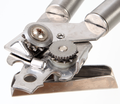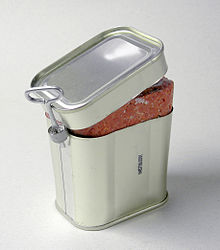tin opener

Can opener is a device for opening metal cans completely . Individual holes, such as in condensed milk cans, can also be made with a can punch .
history
The can was registered for a patent in 1810 by the Englishman Peter Durand . It found its first wide application from 1813 in the Royal Navy and the British Army. The cans, which were comparatively thick-walled at the time, were opened with the cutting and striking tools available in the field, especially with strong knives such as the bayonet , sometimes with a hammer and chisel or an ax.
A special device for opening cans was first invented in 1855 by Robert Yeates from England and patented in 1858 . As a result, the American Ezra J. Warner applied for a new patent in 1858 for a can opener, which was also used in the US Army. In 1870, the American William Lyman invented the can opener with cutting wheel, which is still used today, and which was particularly successful because thinner sheet metal was now used for can production.
Effectiveness and Variations
With the spread of the tin can, numerous variations of opening devices have developed. The effectiveness is different depending on the model, it depends not only on the correct handling of the simple instruments but also on the material and shape of the can, as well as the previous wear and tear of the transport and cutting tools. Can openers often fail towards the end of the cutting process when the can edge changes shape under the pressure of the tool and the holding hand and thus hinders the tool's movement. Newer models solve the surrounding fold instead of the cover plate, whereby no sharp edges arise.
Simple instruments
With simple instruments, a hole is mostly punched into the lid with a point and a cutting surface is guided along the edge of the lid with more or less skill, force and repeated lever movements. Depending on the technology used, the cover sheet is cut open or torn open, sometimes combining both separation processes.
P-38 opener
The "P-38 opener", which was regularly attached to the combat rations of the United States Armed Forces in World War II until well into the 1980s, gained fame . It consists of a perforated and profiled sheet metal piece that serves as a handle and a metal tooth that can be folded out. A groove under the metal tooth is used to snap into the protruding edge of the can. By vigorously turning the handle plate, the metal tooth cuts into the lid using the leverage effect on the can edge. The tool got its name from its length of 38 millimeters. The P-38 opener was always delivered wrapped in brown packing paper. On this was a picture to explain the use as well as instructions for sterilization , according to which the device should be strung on a string and held in boiling water. Officially, the device was called the US Army pocket can opener , which in addition to opening cans for numerous other purposes, e.g. B. was used as a screwdriver or to cut fishing lines, etc. The P-38 has been copied in large numbers and was popular with scouts and hikers in Germany under the name "Wanderfreund". It usually found its place in the ID card holder or purse, because it was usually no longer easy to find in confusing trouser pockets. In addition to the P-38 there was also the larger version "P-51". In the GDR , too, there was a replica called Standard , the grip plate of which had rounded ends.
Part of multi-purpose tools
Can opener devices of the type of simple instruments can often be found on army and camping cutlery , pocket knives or multifunctional tools . Disadvantages are often considerable possibilities of injury directly with these devices or through jagged can edges as well as possibly remaining metal chips in the can contents.
Instruments with transport wheel
More complex instruments have a lever handle or pincer handles with which a toothed transport wheel is pressed against the protruding edge of the can. When the one-hand lever or an additional rotating mechanism is operated, the cutting tool is guided along the inside edge or outside of the fold of the can lid. Cutting or parting tools are mandrels or cutting wheels. Can openers, which cut open the lid on the inner edge of the fold, dip their cutting edge into the inside of the can and thus come into contact with the contents of the can. There is also the risk of the lid falling into the can when it is opened. Can openers that separate the lid from the can on the outside of the fold, so-called edge cutters, have the advantage that the lid cannot fall into the can and the lid can be put back on. In addition, there are no sharp burrs on the can or the lid. However, these openers may have problems earlier if the fold is of improper dimensions.
Electrically operated devices
In the case of can openers with an electric drive, the can to be opened is simply placed on the can fold and guided once all around the knife of the opener by a drive mechanism . Openers around the can cut off a lid. Some kitchens have an integrated can opener that is installed in a suitable place and is usually operated electrically.
Built-in can opener
In beverage cans has been since 1962 in the United States lift tab used, bringing cans were first opened without tools. A pre-stamped, often relatively narrow tongue ended in the middle, where a simple tab was attached with a rivet. This one folded up and could release the rest of the tongue. The 1963 patented, improved ring-pull ripping (English: ring-pull tab ) was until the late 1980s / early 1990s very common. Today, the stay-on closure, invented in 1974, is used here , in which the ring is pressed upwards, whereby a pre-stamped piece of cover sheet is pressed into the inside of the can. The ring is then folded back onto the lid. The latest development are resealable beverage cans with the so-called Ball Resealable End from Ball Packaging Europe , in which a plastic closure has to be turned clockwise to open and back to close.
Tins of sardines or corned beef cans often have side a sheet metal tab that is inserted into a key-shaped, slotted rotary tool on the cover sheet or. The cover plate or a narrow, pre-embossed strip of the can wall is then released by winding it up with the rotary tool. The turning tool is either included in the package or soldered to the box. In the latter case, the wrench can be broken for use at a predetermined breaking point by bending it back and forth. These cans often cannot (easily) be opened with conventional can openers because the flared edge on the lid / base is different.
Tin cans with the ring-pull system for ready meals did not come onto the market until 1990. The lid is pre-embossed on the edge, with more rectangular fish tins, the embossing tapers towards the ring. When the ring is folded up, a first small, round point is pressed in and the rest of the lid can be pulled off with the help of the ring.
Others
- In a secondary meaning that goes back to Akif Pirinçci's novel Felidae , cat owners often self-ironically refer to themselves as can openers or dosies . They express what they see (with the eyes of their cat as it were) as their own main reason for existence.
- The aircraft Henschel Hs 129 was given the nickname "can opener" since it with its armor-piercing weapons primarily for anti-tank was used fighting.
See also
literature
- Herbert Hartkopf: The long way to get down to business . In: Franz Metzger (ed.): Zipp and zu . Stuttgart 2008. ISBN 978-3-8062-2165-7 , pp. 21-24.
- »Had tin« , article in the FAZ about can openers from February 25, 2014
Web links
Individual evidence
- ↑ " I inclose place and the Said food or articles in bottles, or other vessels of glass, pottery, tin, or other metals, or materials fit. "In: The Repertory of Arts, Manufactures, and Agriculture. P. 193. limited preview in Google Book search.
- ↑ Patent US19063 : Can Opener. Published January 5, 1858 , inventor: Ezra J. Warner.
- ↑ Patent US105346 : Can Opener. Published July 12, 1870 , inventor: William W. Lyman.
- ^ G / History , Johan Michael Sailer Verlag, 2005, p. 59.







